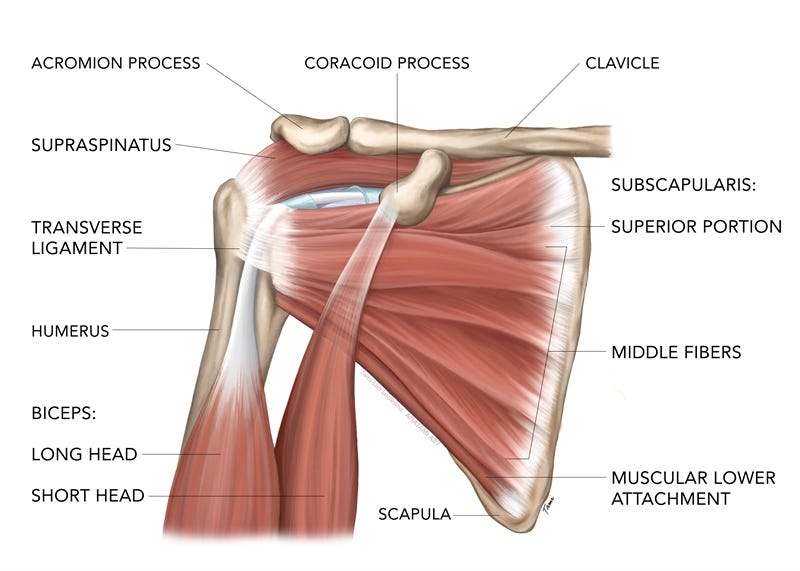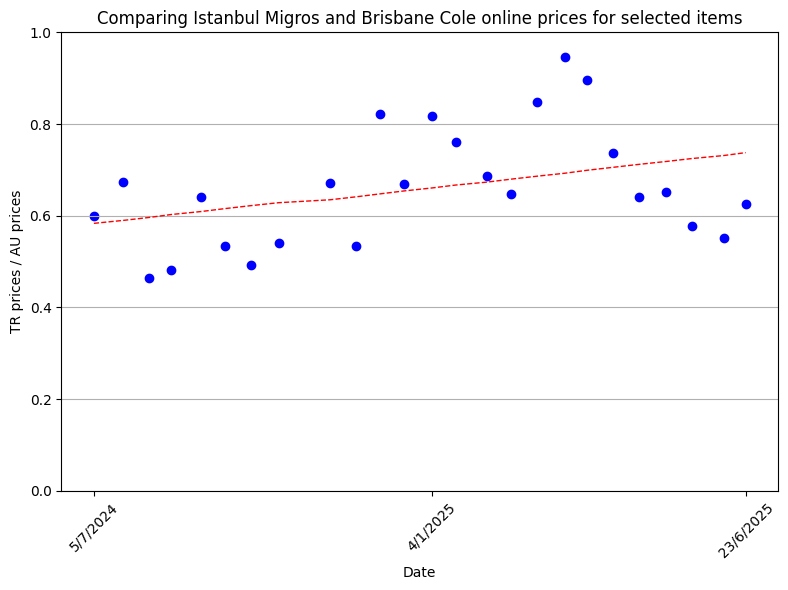If you like what you read, copy and share the link, post it on another platform.
Please also subscribe to make sure you will not miss future posts. Subscription is free. Your email will not be used for other purposes. You will receive no advertisements.
-+-+-+-+
Part 1: From Gym Routine to Sharp Shoulder Pain
Meliz and I had to stop going to the gym when COVID hit in 2020. Before then, we were fairly regular with our routine. It took us a while to return — we finally got back into it last October.
When I resumed, I picked up right where I had left off in 2020, following the same schedule and exercises. Early on, I noticed some pain in my upper right arm. I assumed it was just a normal result of muscle weakening during the COVID break — nothing a bit of perseverance and regular training couldn’t fix.
So I pushed on, repeating the familiar mantra: no pain, no gain. I thought I just needed to get through the soreness.
But the pain didn’t go away. In fact, it grew worse. Eventually, it reached a level where I had to stop the specific exercise that was causing the discomfort. Still, I continued with the rest of my gym program.
Then, about three weeks ago, things changed drastically.
The pain in my right arm escalated rapidly — not just during workouts, but even at rest. Suddenly, even the smallest movement would trigger pain. My arm felt fragile.
That’s when I realized this wasn’t just post-workout soreness anymore. I needed to get professional help. The pain wasn’t unbearable yet, but it was persistent and worsening. So I decided to see a physiotherapist.
Part 2: Seeking Help — From Physio Visit to Worsening Pain
I made an appointment to see a physiotherapist. During the session, he had me perform a few basic movements — raising my right arm, rotating it, lowering it again. At that stage, while the pain was sharp in certain areas, I still had reasonable mobility.
He suspected that the problem involved the subscapularis tendon, where it connects to the shoulder cup. Interestingly, although the pain seemed to radiate from my upper arm, he explained that this was due to the way the nerves transmit pain — the actual trouble spot was likely deeper, where the tendon joins the shoulder.
He prescribed a couple of strengthening exercises, one of which involved using a 3-kilogram dumbbell. I did them the next day. The pain was manageable — I recorded it as a level 3 on the scale.
On Saturday, I repeated the same exercises, but the pain increased. This time, it was more like a level 5.
By Monday, things took a sharp turn. I couldn’t complete the exercises even without the weight. My right arm felt like it had turned to glass — every minor movement triggered sharp, stabbing pain.
I started grumbling and moaning, as one does when something’s clearly not right, and Meliz stepped in firmly. “This isn’t working,” she said. “We need to take this seriously.”
Part 3: Escalation and a Clearer Diagnosis Path
I called the physiotherapist and told him, “This really isn’t working.” He asked me to come in the next day — that was Monday, and we set the appointment for Tuesday.
He also strongly recommended that I see my GP, our regular family doctor who’s been with Melis and me for years. Fortunately, the good doctor had a Friday morning slot available. Not immediate, but still within the same week, which felt like a small mercy.
I saw the physio on Tuesday. We repeated the basic assessments, but this time the difference was obvious — I no longer had the mobility I did just a week earlier. The pain had changed everything.
He told me the condition was now clearly more complex. He suspected one of two things:
Frozen shoulder (adhesive capsulitis),
Or calcific tendinitis — a buildup of calcium in the tendons connecting to the shoulder cup.
To distinguish between the two, he said, we’d need imaging. It was a good thing I already had an appointment with the doctor, who had the authority to prescribe scans. The Physio advised I request ultrasound and X-ray scans of my right shoulder and upper arm.
He mentioned that an MRI would give the most definitive picture but X-rays and ultrasounds were covered by Medicare, whereas the MRI would be fully out-of-pocket. At that point, I was perfectly willing to pay for the MRI if necessary — but I agreed it was best to see the GP first before making that call.
Part 4: A Diagnosis and a Blade-Like Pain
Friday morning, I saw our GP. After listening to my description of the symptoms and putting me through some basic movement checks, he confirmed what the physiotherapist had suspected. But he leaned more strongly toward a diagnosis of calcific tendinitis rather than frozen shoulder.
There were two main reasons for his conclusion:
The symptoms had developed too quickly for frozen shoulder.
The pain was far too sharp and intense. Frozen shoulder pain tends to be dull and aching — mine was neither.
He explained that in calcific tendinitis, calcium crystals form inside the tendon and act like tiny blades when the muscle is moved. They cut into the surrounding tissue, causing intense pain.
That description hit home. I’ve never had kidney stones, thankfully, but I’ve heard the horror stories — pain like being stabbed from the inside. What I felt in my shoulder wasn’t far off. Every small motion felt like someone was slicing through muscle with a knife.
The doctor told me to continue with Panadol, but to also start taking Mobic (meloxicam), a strong non-steroid anti-inflammatory — one tablet each evening with dinner.
I went straight to the pharmacy, picked up the prescription, and headed home.
Part 5: Sweat, Sleep, and a Glimmer of Relief
Friday night, I took my first Mobic tablet with dinner. Afterward, I read a bit, watched some TV, and eventually went to bed. I slept well — until 3 a.m.
At exactly 3 a.m., I woke up completely soaked in sweat. It felt like I had been hosed down. My pyjamas, underwear, even the pillowcase — all drenched.
Trying not to wake Melis, I got up, changed clothes quietly, and slipped back under the covers. I fell back asleep quickly — and woke up at 6 a.m. feeling surprisingly refreshed.
Saturday went well. I felt better — not pain-free, but improved. I kept taking Panadol every six hours, and that night, I took my second Mobic with dinner.
Same bedtime routine. And once again, I woke up at around 3 a.m., sweating — though this time not quite as much. We were prepared: Meliz had set out fresh pyjamas, underwear, and even a towel to lay over the sheet.
I changed quickly, laid down the towel, and went back to sleep — and again, slept soundly until morning.
Part 6: A Turn Toward Recovery
Sunday morning came, and I felt good. I followed my usual routine — a trip to the Mt Gravatt Farmers’ Market. I was careful not to carry anything heavy, especially with my right arm, but even so, I noticed I was moving more easily.
The rest of the day passed without incident. And now, as I write this on Sunday night, I can say:
I feel much better.
There’s no pain in my upper arm. The stabbing, cutting sensation is gone. I know it’s not how biology works, but I can’t help but wonder if all that sweating somehow flushed something toxic out — as if it “washed away” the calcium crystals. Maybe that’s nonsense. But it feels like it.
I know recovery isn’t linear, and this might not be the end — but I’m clearly on the recuperation path. I’m hopeful. And grateful.
Consider Phlebas
I’ve decided to treat this episode as a warning. Though I’m in reasonably good health and often feel as energetic as I did when I was younger, the truth is: I am not young anymore. The body no longer repairs itself with the same speed or resilience it once had.
I’ll continue to exercise, of course — it’s too important to stop. But I’ll do so with more caution and more respect for the natural limits that come with age. When I was younger, those limits could be pushed. That gets harder now, and ignoring that reality comes at a cost.
The title of this post, Consider Phlebas, is a reminder to myself.
Who is Phlebas?
He is the Phoenician sailor mentioned in T. S. Eliot’s The Waste Land:
O you who turn the wheel and look to windward,
Consider Phlebas, who was once handsome and tall as you.
Phlebas, like many of us, once thought he was untouchable. Eliot asks the reader to pause and reflect — on the transience of youth and the unstoppable passage of time.
Consider Phlebas is also the title of the first novel in Iain M. Banks’ Culture series, one of the most imaginative visions of a post-scarcity future. The book follows Horza, a young, impulsive shape-shifter who repeatedly takes risks — often without clear motivation or reward. In some ways, he too ignores his limits until the consequences catch up with him.
I reread the novel last month and still highly recommend it. Incidentally, the Culture universe offers a provocative answer to one of our era’s biggest questions: What happens if we get the AI balance right?
In that world, there is no money, because resources are abundant and managed by a symbiosis of humans and advanced artificial intelligences. The Culture is peaceful, creative, and expansive — but not without its critics. Horza, in fact, opposes the Culture, viewing it as a heretical form of human life, where AI has taken the lead.
I don’t share his view. In many ways, I admire the Culture — and perhaps aspire to aspects of it. But Eliot’s warning still holds. Even in a future shaped by AI and abundance, our own bodies would still belong to time.
-+-+-+-+
Comparing Istanbul and Brisbane prices - AT index
Based on my basket of goods, Australia is 60% more expensive this week compared to Istanbul. Both Coles (AU) and Migros (TR) prices are expressed in Turkish liras for the items in the basket on 23 June 2025. I converted Coles prices to Turkish liras at the exchange rate of 1AUD=25.36 TRY.
Although the trend (the red dotted line) is rising, which means that, since 5 July 2024, the Turkish prices have been slowly approaching the Australian prices, it started flattening in recent months. Some items, e.g. beef mince and rice, are more expensive than in Brisbane and has been consistently so since I started this chart.
The following chart shows the variation of the total cost for the basket in each country separately taking 5 July 2024 as the base.
Wages
The Australian minimum wage was increased to almost $25/h on 3 June 2025. This corresponds to A$4000/month for a 160-hour month. The Australian workers being paid the minimum wage are about 2.6 million or about 18% of the total Australian work force.
The minimum wage in Turkey is 26,000 TRY/month. At the current exchange rate this corresponds to A$1018/month.
The code to create the above tables and the charts is in my github repository and can be downloaded if you are interested.



